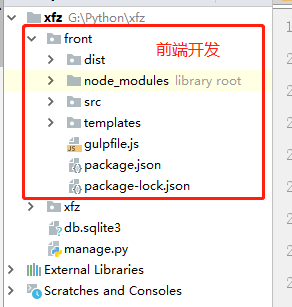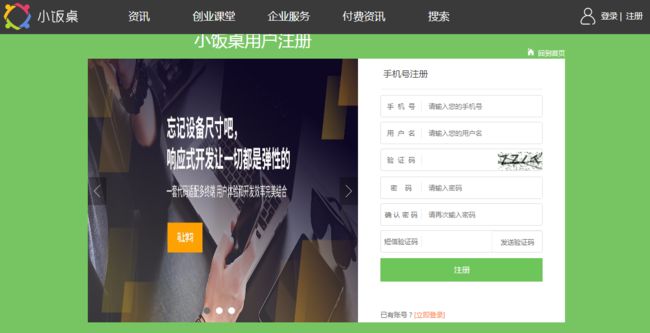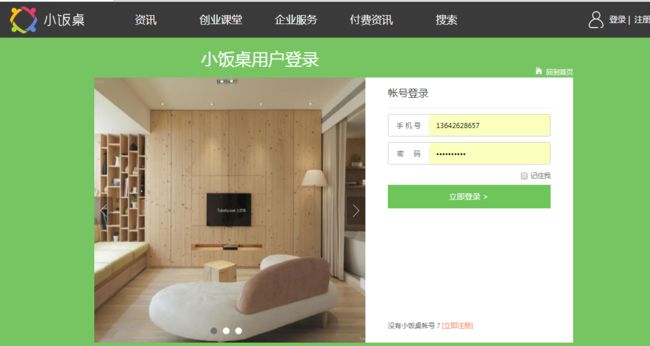Django打造大型企业官网-项目实战
一、项目环境搭建
1、新建虚拟环境:mkvirtualenv project_name
2、pycharm 新建 Django 项目:xfz
3、 删除 xfz 项目中的 templates 目录,新建 front 目录。项目 xfz 初始目录如下:
4、front 前端环境初始化
1)进入front目录,打开终端,执行命名:npm init ,进行npm 初始化,执行完成会生成一个 package.json 跟一个 package_lock.json 文件
2)当前项目下安装 gulp :npm install gulp --save-dev , 安装完成后会生成一个 node_modules 包
3)在front 目录下,新建js文件:gulpfile.js
4)我们将之前安装过的 gulp 插件命令,拿到本项目中用:
{ "name": "xfz_front", "version": "1.0.0", "description": "", "main": "index.js", "scripts": { "test": "echo \"Error: no test specified\" && exit 1" }, "author": "", "license": "ISC", "devDependencies": { "browser-sync": "^2.26.3", "gulp": "^4.0.0", "gulp-cache": "^1.1.1", "gulp-concat": "^2.6.1", "gulp-cssnano": "^2.1.3", "gulp-imagemin": "^5.0.3", "gulp-rename": "^1.4.0", "gulp-uglify": "^3.0.2" } }
5)终端下执行命令:npm install , 对 package.json 中 devDependencies 下的所有插件进行安装。
至此便完成了前端环境的初始化,接下来需要在 gulpfile.js 文件中,对 一些源文件进行相应的预处理(压缩)
5、编写 gulpfile.js 文件
创建处理 css 的任务
创建处理 js 的任务
创建处理 images 的任务
创建处理 html 的任务
创建监听任务
实现指定文件内容修改时,自动刷新浏览器内容
var gulp = require("gulp"); // gulp 插件 var cssnano = require("gulp-cssnano"); // css 压缩 var rename = require("gulp-rename"); // 重命名,加后缀等 var uglify = require("gulp-uglify"); // js 压缩 var concat = require("gulp-concat"); // 文件拼接 合并 var cache = require("gulp-cache"); // 缓存 var imagemin = require("gulp-imagemin"); // 图片压缩 var bs = require("browser-sync").create(); // 浏览器自动刷新 var sass = require("gulp-sass"); // sass 压缩 var util = require("gulp-util"); // 这个插件中有一个 log 方法,可以用来打印当前 js 错误信息。需安装 // 定义全局路径 var path = { 'html':'./templates/**/', 'css':'./src/css/**/', 'js':'./src/js/**/', 'images':'./src/images', 'css_dist':'./dist/css/', 'js_dist':'./dist/js/', 'images_dist':'./dist/images' }; // 初始化 browser-sync 的任务 gulp.task("bs",function(){ bs.init({ 'server':{ 'baseDir':'./' } }); }); // 定义处理 HTML 文件的任务 gulp.task("html",function () { gulp.src(path.html + '*.html') .pipe(bs.stream()) // html文件更改时,浏览器会自动刷新 }); // 定义处理 css 的任务 gulp.task("css",function(){ gulp.src(path.css + '*.scss') .pipe(sass().on("error",sass.logError)) // 将 scss 文件转换成 css 文件,如果出错则打印错误信息 .pipe(cssnano()) // 压缩 css 文件 .pipe(rename({"suffix":".min"})) .pipe(gulp.dest(path.css_dist)) .pipe(bs.stream()) }); // 定义处理 js 的任务 gulp.task("js",function () { gulp.src(path.js + '*.js') .pipe(uglify().on("error",util.log)) // js 文件压缩错误时打印错误信息 .pipe(rename({"suffix":".min"})) .pipe(gulp.dest(path.js_dist)) .pipe(bs.stream()) }); // 定义处理图片文件的任务 gulp.task("images",function () { gulp.src(path.images + '*.*') .pipe(cache(imagemin())) .pipe(gulp.dest(path.images_dist)) .pipe(bs.stream()) }); // 定义监听文件修改的任务 gulp.task("watch",function () { gulp.watch(path.html + '*.html',['html']); gulp.watch(path.css + '*.scss',['css']); gulp.watch(path.js + '*.js',['js']); gulp.watch(path.images + '*.*',['images']); }); // 创建一个默认的任务,在终端执行时只需要执行命令:gulp gulp.task("default",["bs",'watch']);
注:gulpfile.js文件内容只适合在 gulp 3的版本中使用,因 gulp 3 和 gulp 4 版本有些不同,如直接运行上述 gulpfile.js 会报错。 当前项目安装 gulp 时,默认会安装 gulp 最新版本,即 gulp 4版本,我们可以通过下述命令让 gulp 4版本回退到 gulp 3 版本(3.9.1):
npm install gulp@3 --save-dev
此时,我们可以在终端执行命令:gulp 来启动我们的前端程序,启动成功终端显示如下图,同时会跳出一个本地ip:3000端口的网页,即我们的前端显示页面。我们可以在浏览器输入网址:http://localhost:3000/templates/news/index.html ,来访问我们的新闻首页。
注:如果报错:Cannon find module "lodash.assign" 错误,直接安装lodash即可,目前package.json依赖如下:
{ "name": "xfz_front", "version": "1.0.0", "description": "", "main": "index.js", "scripts": { "test": "echo \"Error: no test specified\" && exit 1" }, "author": "", "license": "ISC", "devDependencies": { "browser-sync": "^2.26.3", "gulp": "^3.9.1", "gulp-cache": "^1.1.1", "gulp-concat": "^2.6.1", "gulp-cssnano": "^2.1.3", "gulp-imagemin": "^5.0.3", "gulp-rename": "^1.4.0", "gulp-sass-china": "^3.1.0", "gulp-uglify": "^3.0.2", "gulp-util": "^3.0.8", "lodash": "^4.17.11" }, "dependencies": {} }
二、后端开发
前端开发不累述。
在我们借助 gulp 完成前端页面的开发后,正式进入到我们的后端开发。开始后端开发前,需要在 settings.py 中做好以下几步配置工作:
- 配置好数据库
- 配置好模板文件的路径
- 配置好静态文件的路径
- 配置好时区
- 配置好模板的static标签
1)配置好数据库,如下:
Navicat:
数据库配置:
DATABASES = { 'default': { 'ENGINE': 'django.db.backends.mysql', 'NAME': "xfz", 'HOST': "127.0.0.1", 'POST': "3306", 'USER': "root", 'PASSWORD': '***' } }
配置好数据库好,我们还需要进入虚拟环境(workon xfz)中安装 mysqlclient ,这是数据库的依赖包,安装后才能正常连接数据库。
2)配置好模板文件的路径:
templates原配置: 'DIRS': [os.path.join(BASE_DIR, 'templates')] 新: 'DIRS': [os.path.join(BASE_DIR, 'front', 'templates')] # 在front目录下的templates目录
3)配置好静态文件的路径:
STATIC_URL = '/static/' STATICFILES_DIRS = [ os.path.join(BASE_DIR, 'front', 'dist') ]
4)配置好时区:
LANGUAGE_CODE = 'en-us' TIME_ZONE = 'Asia/Shanghai' USE_I18N = True USE_L10N = True USE_TZ = True
5)配置好模板的静态 static 标签 ,这样在模板中使用static语法时就不需要在每个相应的模板页面中 {% load static %} 了 :
TEMPLATES = [ { 'BACKEND': 'django.template.backends.django.DjangoTemplates', 'DIRS': [os.path.join(BASE_DIR, 'front', 'templates')] , 'APP_DIRS': True, 'OPTIONS': { 'context_processors': [ 'django.template.context_processors.debug', 'django.template.context_processors.request', 'django.contrib.auth.context_processors.auth', 'django.contrib.messages.context_processors.messages', ], 'builtins':[ # static 标签配置 'django.templatetags.static' ] }, }, ]
settings.py 相关配置配置完成后,我们新建个apps目录,用来存放所有app ,同时将 apps 目录设为 Sources Root、templates目录设为 Template Folder
接着新建app:news ,并将该app添加进settings.py 中的 INSTALLED_APPS 中:
INSTALLED_APPS = [ 'django.contrib.admin', 'django.contrib.auth', 'django.contrib.contenttypes', 'django.contrib.sessions', 'django.contrib.messages', 'django.contrib.staticfiles', 'apps.news', # 新增 ]
然后,将template模板中设计的的文件/图片路径均改成动态路径,即{% static '...' %}格式。
完成上述步骤后,我们就可以正式进入到后端开发中。
1、使用 xadmin 后台管理系统,而不使用django自带的admin后台系统。xadmin 相关介绍请参考:https://www.cnblogs.com/Eric15/articles/9527556.html
1)依赖包安装:
pip install django-crispy-forms django-reversion django-formtools future httplib2 six # 多个依赖包一起安装 pip install django-import-export pip install xlwt xlsxwriter
2)将xadmin 及 DjangoUeditor 包复制,放到extra_apps(新建)中,在apps中的每个app(创建的app)都添加一个adminx文件
3)在settings.py 中将 apps 、extre_apps 路径配置进去:
# settings.py import sys sys.path.insert(0,BASE_DIR) sys.path.insert(0,os.path.join(BASE_DIR, 'apps')) sys.path.insert(0,os.path.join(BASE_DIR, 'extra_apps'))
3)将xadmin、crispy_forms、DjangoUeditor(富文本编辑器),在setting中进行注册:
INSTALLED_APPS = [ 'django.contrib.auth', 'django.contrib.contenttypes', 'django.contrib.sessions', 'django.contrib.messages', 'django.contrib.staticfiles', 'apps.news.apps.NewsConfig' # 创建的app 用这种形式注册
'xadmin',
'crispy_forms',
'DjangoUeditor',
]
关于 DjangoUeditor → ueditor 富文本使用,可查看博文:https://www.cnblogs.com/Eric15/articles/9589396.html
4)settings.py 中语言改为中文:
# 语言改为中文 LANGUAGE_CODE = 'zh-hans'
5)静态文件/上传文件设置:
# 设置静态文件路径,上面已经设置过 STATIC_URL = '/static/' STATICFILES_DIRS = [ os.path.join(BASE_DIR, "front", "dist"), ] # 用户上传文件存放路径 MEDIA_URL = "/media/" MEDIA_ROOT = os.path.join(BASE_DIR, "media")
6)app 名称中文化:
# news/apps.py class GoodsConfig(AppConfig): name = 'news' verbose_name = "新闻"
7)配置 xadmin 、ueditor 路由:
# xfz/urls.py import xadmin from django.urls import path,include urlpatterns = [ path('xadmin/', xadmin.site.urls), path('ueditor/', include('DjangoUeditor.urls')), ]
8)makemigrations / migrate :生成数据库表
9)创建超级管理员:
python manager.py createsuperuser ,创建超级用户,登录(127.0.0.1:8000/xadmin)xadmin后台管理查看详情
2、系统登录/注册功能,使用django自带的登录功能,实现自定义用户名(邮箱、手机等)登录/注册
2.1、注册功能
主要用到手机号码、用户名、随机验证码、密码及短信验证码等字段,随机验证码我们可以借用第三方库 Captcha 来实现,短信验证码需要另外生成一个表来处理,下面先单独设计用户表,继承于Django 自带的 AbstractUser :
注意:在 AbstractUser 中:REQUIRED_FIELDS = ['mobile'] , 指定创建用户时需输入某个字段,如这里就是要求创建用户时必须输入mobile,另外username、password 是默认必须要输入的字段。
class UserProfile(AbstractUser): """用户""" gender_choices = ( ('male', '男'), ('female', '女') ) nick_name = models.CharField('昵称', max_length=32, default='', null=True, blank=True) birthday = models.DateField('生日', null=True, blank=True) gender = models.CharField('性别', max_length=8, choices=gender_choices, default='female') mobile = models.CharField('手机号', max_length=11, null=True, unique=True) image = models.ImageField(upload_to='image/%Y/%m', default='image/default.png', max_length=100) email = models.EmailField('邮箱', blank=True, unique=True, null=True) # 重写email字段,加上'唯一'标识 is_active = models.BooleanField(default=False) # AbstractUser 类中该字段默认为True is_staff = models.BooleanField(default=True) # AbstractUser 类中该字段默认为False ,为了让前端注册成功后能正常登录后台管理系统,需设为True,同时后续还需要处理权限问题 REQUIRED_FIELDS = ['mobile', 'email'] # 通过manage.py...创建用户/管理员时,会提醒输入此字段(必输入) class Meta: verbose_name = '用户信息' verbose_name_plural = verbose_name def __str__(self): return self.username
要想登录xadmin后台系统,需要同时满足:is_active为True、is_staff为True 两个条件。在AbstractUser 类中默认,is_active=True,is_staff=False ,在下面我们处理的注册相关操作中我们选择通过使用is_active来控制注册用户是否有效可用,因此在这里我们需要重载该字段并设置为 is_active=False、is_staff=True,如上述代码所示 , 这样,通过前端注册并成功激活的用户便能登录前端界面及后端管理后台,这类用户是没有后台任何权限的,我们后续需要配置权限相关操作。接着,我们也需要对 auth/models.py(django内置)中的 UserManager 类下create_superuser 方法进行如下代码优化,目的还是实现:在后台创建超级用户时,超级用户拥有is_active=True、is_staff=True 两个条件,可以登录后台并拥有后台所有权限。
如果要创建能登录后台的普通用户,方法一:可以通过超级用户登录到后台,再创建新普通用户并赋予指定权限就可以了;也可以前端直接注册,成功后照样能登录后台。 当然,如果用户注册时不需要用到is_active条件,在models.py中我们就只需要重载is_staff字段就可以,后续的UserManager 类中我们就不需要更改任何代码了。
# auth/models.py class UserManager(BaseUserManager): use_in_migrations = True def _create_user(self, username, email, password, **extra_fields): """ Create and save a user with the given username, email, and password. """ if not username: raise ValueError('The given username must be set') email = self.normalize_email(email) username = self.model.normalize_username(username) user = self.model(username=username, email=email, **extra_fields) user.set_password(password) user.save(using=self._db) return user def create_user(self, username, email=None, password=None, **extra_fields): extra_fields.setdefault('is_staff', False) extra_fields.setdefault('is_superuser', False) return self._create_user(username, email, password, **extra_fields) def create_superuser(self, username, email, password, **extra_fields): extra_fields.setdefault('is_staff', True) extra_fields.setdefault('is_active', True) # 新增 extra_fields.setdefault('is_superuser', True) if extra_fields.get('is_staff') is not True: raise ValueError('Superuser must have is_staff=True.') if extra_fields.get('is_superuser') is not True: raise ValueError('Superuser must have is_superuser=True.') return self._create_user(username, email, password, **extra_fields)
用户表中用到 ImageField,因此我们需要安装下第三方库:pillow
pip install pillow
用户注册时,需要用到图形验证码及短信验证码,我们先来处理这两个问题
1)图形验证码
1. 使用第三方库:django-simple-captcha
虚拟环境下安装:
注意,使用django-simple-captcha第三方库时会涉及到image,此时如果未安装pillow,则需同时安装pillow:pip install pillow
pip install django-simple-captcha
2. 在项目的setting.py中的INSTALLED_APPS需要注册captcha。同时注册后,需要经过makemigrations、migrate生成对应的表数据(反经过这种注册的app都需要进行 makemigrations 、migrate 操作)
INSTALLED_APPS = [ …… 'captcha', …… ]
3. 在urls.py中配置:
from django.urls import path,include,re_path urlpatterns = [ # 验证码 re_path(r'^captcha', include('captcha.urls')), ]
4. 后台中,需要用到captcha 的地方中使用:
from captcha.fields import CaptchaField class RegisterForm(forms.Form): """注册表单验证""" captcha = CaptchaField(error_messages={'invalid':'验证码错误'})
5. 前端展示 captcha 图形验证码:
{{ register_form.captcha }}
前端中生成的captcha 代码:
6. 在 js 文件中实现点击图形验证码即时更新:
//刷新验证码 function refresh_captcha(event){ $.get("/captcha/refresh/?"+Math.random(), function(result){ $('#'+event.data.form_id+' .captcha').attr("src",result.image_url); $('#id_captcha_0').attr("value",result.key); }); return false; } // 绑定点击事件,点击刷新验证码 $(function() { $('#email_register_form .captcha-refresh').click({'form_id':'email_register_form'},refresh_captcha); // email_register_form 是表单的id $('#email_register_form .captcha').click({'form_id':'email_register_form'},refresh_captcha); })
在 form.py 中进行表单验证时,添加的 captcha 字段是由第三方库 Captcha 内部定义的,内部已经完成验证码验证,即不需要我们再额外判断用户输入图形验证码是否正确
django-simple-captcha 使用时,在settings.py 中的部分可选择配置:
# 格式 CAPTCHA_OUTPUT_FORMAT = u'%(text_field)s %(hidden_field)s %(image)s' # 噪点样式 CAPTCHA_NOISE_FUNCTIONS = ( 'captcha.helpers.noise_null', # 没有样式 # 'captcha.helpers.noise_arcs', # 线 'captcha.helpers.noise_dots', # 点 ) # 图片大小 CAPTCHA_IMAGE_SIZE = (100, 30) # 字符个数 CAPTCHA_LENGTH = 4 # 超时(minutes) CAPTCHA_TIMEOUT = 1 # 文字倾斜 CAPTCHA_LETTER_ROTATION = (-10,10) # 背景颜色 CAPTCHA_BACKGROUND_COLOR = '#FFFFFF' # 文字颜色 CAPTCHA_FOREGROUND_COLOR = '#0A12E5' # 验证码类型 # 图片中的文字为随机英文字母,如 mdsh ,默认就是这种 CAPTCHA_CHALLENGE_FUNCT = 'captcha.helpers.random_char_challenge' # 图片中的文字为数字表达式,如1+2= # CAPTCHA_CHALLENGE_FUNCT = 'captcha.helpers.math_challenge'
2)短信验证码
1. 前端注册页面代码:
{% extends 'front_base.html' %} {% block title %}小饭桌注册{% endblock %} {% block front-css %} <link rel="stylesheet" type="text/css" href="{% static 'css/news_auth/reset.min.css' %}"> <link rel="stylesheet" type="text/css" href="{% static 'css/news_auth/login.min.css' %}"> {% endblock %} {% block front-js %} <script src="{% static 'js/unslider.min.js' %}" type="text/javascript">script> <script src="{% static 'js/login.min.js' %}" type="text/javascript">script> <script src="{% static 'js/validateDialog.min.js' %}" type="text/javascript">script> {% endblock %} {% block body %} <section> <div class="c-box bg-box"> <div class="login-box clearfix"> <div class="hd-login clearfix"> <a class="index-logo" href="/index/">a> <h1>小饭桌用户注册h1> <a class="index-font" href="/index/">回到首页a> div> <div class="fl slide"> <div class="imgslide"> <ul class="imgs"> <li><a href=""><img width="483" height="472" src="{% static 'images/auth/57aa86a0000145c512000460.jpg' %}" />a>li> <li><a href=""><img width="483" height="472" src="{% static 'images/auth/57a801860001c34b12000460.jpg' %}" />a>li> <li><a href=""><img width="483" height="472" src="{% static 'images/auth/57a801860001c34b12000460.jpg' %}" />a>li> ul> div> <div class="unslider-arrow prev">div> <div class="unslider-arrow next">div> div> <div class="fl form-box"> <div class="tab"> <h2>手机号注册h2> div> <div class="tab-form"> <form id="email_register_form" method="post" autocomplete="off"> {% csrf_token %} <div class="form-group marb8 {% if register_form.errors.mobile.0 %} errorput {% endif %}"> <label>手 机 号label> <input type="text" id="id_mobile" name="mobile" {% if register_form.errors.mobile.0 %} placeholder="{{ register_form.errors.mobile.0 }}" {% elif register_form.mobile.value %} value="{{ register_form.mobile.value }}" {% else %} placeholder="请输入您的手机号" {% endif %}/> div> <div class="form-group marb8 {% if register_form.errors.username.0 %} errorput {% endif %}"> <label>用 户 名label> <input type="text" class="form-control" name="username" {% if register_form.errors.username.0 %} placeholder="{{ register_form.errors.username.0 }}" {% elif register_form.username.value %} value="{{ register_form.username.value }}" {% else %} placeholder="请输入您的用户名" {% endif %}> div> <div class="form-group marb8 captcha1 {% if register_form.errors.captcha.0 %} errorput {% endif %}"> <label>验 证 码label> {{ register_form.captcha }} div> <div class="error btns" id="jsEmailTips">{{ register_form.errors.captcha.0 }}div> <div class="form-group marb8 {% if register_form.errors.password1.0 %} errorput {% endif %}"> <label>密 码label> <input type="text" class="form-control" name="password1" {% if register_form.errors.password1.0 %} placeholder="{{ register_form.errors.password1.0 }}" {% else %} placeholder="请输入密码" {% endif %}> div> <div class="form-group marb8 {% if register_form.errors.password2.0 %} errorput {% endif %}"> <label>确 认 密 码label> <input type="text" class="form-control" name="password2" {% if register_form.errors.password2.0 %} placeholder="{{ register_form.errors.password2.0 }}" {% else %} placeholder="请再次输入密码" {% endif %}> div> <div class="form-group marb8 sms_captcha {% if register_form.errors.captcha.0 %} errorput {% endif %}"> <label>短信验证码label> <div class="short-input-group"> <input type="text" class="form-control" name="sms_captcha"> div> <div class="input-group-addon"> <span class="sms-captcha-btn">发送验证码span> div> div> <div class="error btns" id="jsEmailTips">{{ register_form.errors.sms_captcha.0 }}div> <input class="auth-btn btn-green" id="jsEmailRegBtn" type="submit" value="注册" /> form> div> <p class="form-p">已有账号?<a href="{% url 'auth_login' %}">[立即登录]a>p> div> div> div> section> {% endblock %}
2. js 代码,给'发送验证码' 控件绑定点击事件(发送验证码事件),同时实现发送验证码时,该控件显示验证码发送倒计时:
function Auth(){ var self = this; self.smsCaptcha = $('.sms-captcha-btn'); } // 短信验证码 发送短信 绑定点击事件 Auth.prototype.listenSmsCaptchaEvent = function (){ var self = this; var smsCaptcha = $(".sms-captcha-btn"); smsCaptcha.click(function () { // 给 '发送验证码'按钮 绑定点击事件 var token = $('input[name=csrfmiddlewaretoken]').val(); var mobileVal = $("#id_mobile").val(); if(mobileVal.length == 0){ // 判断手机号位数是否为0 alert("请输入手机号码!"); }else if(mobileVal.length == 11) { $.ajax({ cache: false, type: 'post', async: true, // dataType: 'json', url: "/sms_captcha/", data:{ 'mobile': mobileVal, csrfmiddlewaretoken: token }, 'success': function (result) { if(result['code'] == 200){ // 表示发送成功 // result:{code: 200, message: ""} self.smsSuccessEvent(); } }, 'fail': function (error) { console.log(error); } }) } else{ alert("请输入正确的手机号!") } }) }; // 短信验证码倒计时 Auth.prototype.smsSuccessEvent = function(){ var self = this; alert("短信验证码发送成功"); self.smsCaptcha.addClass('disabled'); // 短信发送成功,令该按钮不能再点响应击事件 var count = 60; self.smsCaptcha.unbind('click'); // 解绑点击事件 var timer = setInterval(function () { self.smsCaptcha.text("已发送"+count+"s"); // 验证码倒计时 count -= 1; if(count <= 0){ clearInterval(timer); // 倒计时满1分钟,清除倒计时 self.smsCaptcha.removeClass('disabled'); self.smsCaptcha.text("发送验证码"); // 清除倒计时后,文本改回'发送验证码' self.listenSmsCaptchaEvent(); // 重新绑定点击事件 } },1000) }; // 页面加载完成时执行下述内容 $(function () { // 发送短信验证码 var auth = new Auth(); auth.listenSmsCaptchaEvent(); });
3)使用缓存存储短信验证码:完成短信验证码相关功能之前,我们先完成缓存相关的一些配置
1. 下载 memcached
网上下载 memcached (win版),下载完成打开是这样的:
安装 memcached,进入终端,执行以下命名:
C:/memcached-1.2.1-win32/memcached.exe -d install # 前面是 下载后的memcached 存放的目录
安装完成后,通过以下命名启动 memcached:
C:/memcached-1.2.1-win32/memcached.exe -d start
在任务管理器中可以看到 memcached 服务已经启动:
![]()
此时的 memcached 便是安装完成,以后只要开启,就能正常用于各个项目中。
2. 在python - django 项目中使用
memcached 安装完成后,我们要在python - django 项目中使用,需要在项目中安装 python-memcached ,安装完成即可正常使用
pip install python-memcached # 虚拟环境
3. memcached 在项目settings.py 中配置:
# 缓存配置 CACHES = { 'default': { 'BACKEND': 'django.core.cache.backends.memcached.MemcachedCache', 'LOCATION': '127.0.0.1:11211' } }
测试:
# pycharm Django console 环境下 >>> from django.core.cache import cache >>> cache.set("haha",1234,60) >>> cache.get("haha") 1234 # 获取到的结果
4)完善短信验证码后端相关功能
views.py:
从前端点击 '发送验证码' 后,后端需要起一个函数来处理前端提交过来的信息,及返回数据(发送短信)
from django.http import JsonResponse from django.core.cache import cache from utils.random_code import generate_code from utils.aliyunsdk import aliyun_send_sms # @csrf_exempt # 短信验证码,可以不需要csrf_token验证 def sms_captcha(request): """注册-发送短信验证码""" # /sms_captcha/?mobile=136*** if request.method == "POST": mobile = request.POST.get('mobile') code = generate_code() # 四位数验证码 cache.set(mobile, code, 5*60) # 以mobile为key,code为value,保存到缓存中,过期时间为5分钟 print(cache.get(mobile)) # 查看是否已保存到缓存中 send_sms_status = aliyun_send_sms(mobile=mobile, code=code) # 发送短信验证码 if send_sms_status == 'OK': # {"code":400,"message":""} 返回json格式 return JsonResponse({"code": 200, "message": ""}) else: return JsonResponse({"code": 400, "message": "短信发送不成功!"})
urls.py配置:
from django.urls import path, include, re_path from xfz.views import sms_captcha urlpatterns = [ path("sms_captcha/", sms_captcha, name='sms_captcha'), ]
aliyun_send_sms.py:
阿里云短信验证码使用参考教程:https://www.cnblogs.com/Eric15/p/10925460.html
import json from aliyunsdkcore.client import AcsClient from aliyunsdkcore.request import CommonRequest from utils.random_code import generate_code def aliyun_send_sms(mobile=None, code=None): """阿里云发送短信""" client = AcsClient('******', '********', 'default') #、 request = CommonRequest() request.set_accept_format('json') request.set_domain('dysmsapi.aliyuncs.com') request.set_method('POST') request.set_protocol_type('https') # https | http request.set_version('2017-05-25') request.set_action_name('SendSms') request.add_query_param('PhoneNumbers', mobile) request.add_query_param('SignName', "小饭桌网站") request.add_query_param('TemplateCode', "SMS_******") request.add_query_param('TemplateParam', json.dumps({'code': code})) # 以json 格式传递code参数 response = client.do_action(request) # 发送短信 response = str(response, encoding='utf-8') # 返回的response 为类型,将其转换成str字符串类型 response = json.loads(response) # 再通过json.loads,将str类型的 response 转换成dict 格式 # print(response) # response:{'Message': 'OK', 'RequestId': 'F07A40C3-539C-453B-BE52-4B60FF8DF58E', 'BizId': '431121158876223912^0', 'Code': 'OK'} # print(response['Code']) # 获取 Code 值 return response['Code']
random_code.py:
import random def generate_code(): """生成四位数的验证码""" seeds = "1234567890" random_str = [] for i in range(4): random_str.append(random.choice(seeds)) return "".join(random_str)
4)处理好图形验证码、短信验证码之后,接下来可以来完善注册相关的功能了。
1. forms.py:
import re from django import forms from django.core.exceptions import ValidationError from django.core.cache import cache from captcha.fields import CaptchaField class RegisterFrom(forms.Form): """用户注册form表单""" mobile = forms.CharField(required=True, max_length=11, min_length=11, error_messages={'min_length': '手机号只能是11位数!', 'max_length': '手机号只能是11位数!' }) username = forms.CharField(required=True, max_length=20) # 生成验证码图片及输入框 captcha = CaptchaField(required=True, error_messages={'invalid': '验证码错误', 'required': '验证码不能为空'}) password1 = forms.CharField(required=True, min_length=8, error_messages={'required': '密码不能为空', 'min_length': '密码不能低于8个字符'} ) password2 = forms.CharField(required=True, min_length=8, error_messages={'required': '密码不能为空'}) sms_captcha = forms.CharField(min_length=4, max_length=4) def clean_password1(self): if self.cleaned_data.get('password1').isdigit() or self.cleaned_data.get('password1').isalpha(): raise ValidationError('密码必须包含数字和字母') else: return self.cleaned_data['password1'] def clean_mobile(self): mobile_re = re.compile(r'^(13[0-9]|15[012356789]|17[678]|18[0-9]|14[57])[0-9]{8}$') mobile_value = self.cleaned_data.get('mobile') if not mobile_re.match(mobile_value): raise ValidationError('手机号码格式错误') else: return self.cleaned_data['mobile'] def clean_sms_captcha(self): """短信验证码存于cache中, 验证短信验证码是否正确""" mobile = self.cleaned_data.get('mobile') sms_captcha = self.cleaned_data.get('sms_captcha') cached_sms_captcha = cache.get(mobile) if not cached_sms_captcha or cached_sms_captcha != sms_captcha: raise ValidationError('短信验证码错误!') else: return self.cleaned_data['sms_captcha'] def clean(self): cleaned_data = super(RegisterFrom, self).clean() if cleaned_data.get('password1') != cleaned_data.get('password2'): raise ValidationError('密码不一致') else: return self.cleaned_data
2. views.py:
from django.shortcuts import render, redirect, HttpResponse from django.contrib.auth import authenticate, login, logout from .forms import RegisterFrom from users.models import UserProfile def xfz_register(request): """注册""" if request.method == "POST": register_form = RegisterFrom(request.POST) if register_form.is_valid(): mobile = request.POST.get('mobile', None) if UserProfile.objects.filter(mobile=mobile): # 用户已经存在,不需要再注册 return render(request, 'register.html', {'msg': '用户已经存在', 'register_form': register_form}) pwd = request.POST.get('password1', None) username = request.POST.get('username', None) # 将密码加密后再保存 pwd = make_password(pwd) user = UserProfile.objects.create( mobile=mobile, username=username, is_active=True, password=pwd ) login(request, user) return redirect('/index/') else: return render(request, 'register.html', {'msg': '注册输入的数据有误', 'register_form': register_form}) else: register_form = RegisterFrom() return render(request, "register.html", locals())
3. urls.py:
from django.urls import path, include, re_path from xfz.views import xfz_register urlpatterns = [ path("register/", xfz_register, name='auth_register'), ]
4. html:相关代码上面已经给出。
至此,注册的功能便完成了!
2.2、登录功能
1)users/models.py:
from django.db import models from django.contrib.auth.models import AbstractUser from datetime import datetime class UserProfile(AbstractUser): """用户""" gender_choices = ( ('male','男'), ('female','女') ) nick_name = models.CharField('昵称', max_length=32, default='', null=True, blank=True) birthday = models.DateField('生日', null=True, blank=True) gender = models.CharField('性别', max_length=8, choices=gender_choices, default='female') mobile = models.CharField('手机号', max_length=11, null=True, unique=True) image = models.ImageField(upload_to='image/%Y/%m', default='image/default.png', max_length=100) email = models.EmailField('邮箱', blank=True, unique=True, null=True) # 重写email字段,加上'唯一'标识 REQUIRED_FIELDS = ['mobile', 'email'] # 通过manage.py...创建用户/管理员时,会提醒输入此字段(必输入) class Meta: verbose_name = '用户信息' verbose_name_plural = verbose_name def __str__(self): return self.username
2)form.py:
import re from django import forms from django.core.exceptions import ValidationError class LoginForm(forms.Form,common_forms.FormMixin): """登录验证""" mobile = forms.CharField(required=True, max_length=11, min_length=11, error_messages={'min_length': '手机号只能是11位数!', 'max_length': '手机号只能是11位数!' }) password = forms.CharField(required=True, min_length=8, error_messages={'min_length': '密码最少不能少于8个字符!'} ) remember = forms.IntegerField(required=False)
common_forms.py: 也可以像注册那样,直接在forms中写,不需要另外处理error
class FormMixin(object): """ 用于获取表单验证失败时的错误信息,存进字典里 """ def get_error(self): if hasattr(self, 'errors'): # 如果有errors这个属性 errors = self.errors.get_json_data() new_errors = {} for key, message_dicts in errors.items(): messages = [] for message in message_dicts: messages.append(message['message']) new_errors[key] = messages return new_errors else: return {}
3)views.py:
from django.db.models import Q from django.shortcuts import render, redirect from django.contrib.auth.backends import ModelBackend from django.contrib.auth import authenticate, login, logout from django.contrib.auth.hashers import make_password from .forms import LoginForm from users.models import UserProfile class CustomBackend(ModelBackend): """ 用于login用户登录验证 需在settings中配置好authenticate验证方式(即在此进行authenticate的相关验证) """ def authenticate(self, request, username=None, password=None, **kwargs): # 重写authenticate方法 try: user = UserProfile.objects.get(Q(username=username)|Q(mobile=username)) if user.check_password(password): """ 1.在注册时,我们对密码使用了加密处理(django下的make_password),因此在登录验证密码时需要先将明文密码加密 后才能跟数据库中已加密后的密码进行比较 2.check_password()是AbstractUser类中的方法,UserProfile继承于AbstractUser,check_password会加密明文密 码后,与数据库密码做对比,再进行判断两密码是否一致 3.验证如果为True,表示密码一致;为False,表示密码不一致 """ return user else: return None except Exception as e: return None def xfz_login(request): """登录""" login_form = LoginForm() if request.method == 'POST': login_form = LoginForm(request.POST) if login_form.is_valid(): mobile = login_form.cleaned_data.get('mobile') password = login_form.cleaned_data.get("password") remember = login_form.cleaned_data.get('remember') user = authenticate(request, username=mobile, password=password) if user: if user.is_active: login(request, user) if remember: request.session.set_expiry(None) else: request.session.set_expiry(0) return redirect('/news/') else: return render(request, 'login.html', {'msg': '用户未激活', 'login_form': login_form}) else: return render(request, 'login.html', {'msg': '用户名或密码错误', 'login_form': login_form}) else: return render(request, 'login.html', {'msg': '用户名或密码格式错误,请重新输入!', 'login_form': login_form}) return render(request, 'login.html')
4)login.html:
{% extends 'front_base.html' %}
{% block title %}小饭桌登录{% endblock %}
{% block front-css %}
"stylesheet" type="text/css" href="{% static 'css/news_auth/reset.min.css' %}">
"stylesheet" type="text/css" href="{% static 'css/news_auth/login.min.css' %}">
{% endblock %}
{% block front-js %}
{% endblock %}
{% block body %}
class="c-box bg-box">
class="login-box clearfix">
class="hd-login clearfix">
class="index-logo" href="{% url 'index' %}">
小饭桌用户登录
class="index-font" href="{% url 'index' %}">回到首页
class="fl slide">
class="imgslide">
class="unslider-arrow prev">
class="unslider-arrow next">
{% endblock %}
5)继承:front_base.html
"en"> "UTF-8">{% block title %}小饭桌{% endblock %} "stylesheet" href="{% static 'css/news/index.min.css' %}"> {% block front-css %}{% endblock %} {% block front-js %}{% endblock %}class="header"> {% block body %}class="container">class="nav">class="daohangtiao">
- if request.path|slice:'5' == '/news' %}class="active"{% endif %} >"{% url 'index' %}">资讯
- if request.path|slice:'8' == '/courses' %}class="active"{% endif %} >class="chuangyeketang" href="{% url 'course' %}">创业课堂
- class="qiyefuwu" href="#">企业服务
- if request.path|slice:'8' == '/payinfo' %}class="active"{% endif %} >"{% url 'payinfo' %}">付费资讯
- if request.path|slice:'7' == '/search' %}class="active"{% endif %} >"{% url 'search' %}">搜索
class="auth-box"> {% if request.user.is_authenticated%}class="auth-login">class="personal">class="user">class="current-user">{{ request.user }}
class="top-down">"{% static 'images/auth/top_down.png' %}"/> class="touxiang">
"45" height="45" src="{{ MEDIA_URL }}{{ request.user.image }}"/>
class="userdetail">{% else %}class="personal-info">"60" height="60" src="{{ MEDIA_URL }}{{ request.user.image }}"/>
class="user-info">{{ request.user }}
{{ request.user.nick_name }}111
class="personal-center"> class="personcenter" href="#">进入个人中心 class="fr" href="{% url 'auth_logout' %}">退出class="personal-p">
{% endif %}class="main">{% endblock %}class="wrapper"> {% block left-content %}class="main-content-wrapper">{% endblock %} {% block right-wrapper %}class="banner-group" id="banner-group">class="banner-ul" id="banner-ul">
class="left-btn btn">‹ class="right-btn btn">›- "#">
"{% static 'images/banners/lunbo_2.jpeg' %}" alt="">
- "#">
"{% static 'images/banners/lunbo_3.jpg' %}" alt="">
- "#">
"{% static 'images/banners/lunbo_4.jpg' %}" alt="">
- "#">
"{% static 'images/banners/lunbo_5.png' %}" alt="">
class="news-list-group">class="news-inner">class="news-list">
"http://static-image.xfz.cn/1516169692_914.jpg-website.news.list" alt="">
class="news-group">class="title"> "#">王健林卖掉进军海外首个项目:17亿售伦敦ONE六成股权
class="desc"> 外界关于万达要出售此前在海外投资项目的消息一直不断。
class="more"> class="category">深度报道 class="pub-time">1小时前 class="author">知了课堂
"http://static-image.xfz.cn/1516169692_914.jpg-website.news.list" alt="">
class="news-group">class="title"> "#">王健林卖掉进军海外首个项目:17亿售伦敦ONE六成股权
class="desc"> 外界关于万达要出售此前在海外投资项目的消息一直不断。
class="more"> class="category">深度报道 class="pub-time">1小时前 class="author">知了课堂
class="load-more-group">class="sidebar-wrapper">{% endblock %}class="platform-group">class="online-class"> class="class-title">关注小饭桌class="focus-group">class="left-group">
- class="zhihu"> "#" target="_blank">小饭桌创业课堂
- class="weibo"> "#" target="_blank">小饭桌创业课堂
- class="toutiao"> "#" target="_blank">小饭桌
class="right-group">class="desc">扫码关注小饭桌微信公众平台xfz008
class="hot-news-group">class="online-class"> class="class-title">热门推荐class="hot-list-group">
class="title"> "#">王健林卖掉进军海外首个项目:17亿售伦敦ON...
class="more"> class="category">"#">深度报道 class="pub-time">1小时前
class="title"> "#">王健林卖掉进军海外首个项目:17亿售伦敦ON...
class="more"> class="category">"#">深度报道 class="pub-time">1小时前
6)urls.py:
from django.urls import path,include, re_path from xfz.views import xfz_logout urlpatterns = [ path("login/", xfz_login, name='auth_login'), ]
2.3、退出登录功能
退出登录功能比较简单,只需要views.py 及 urls.py相关代码处理即可,如下
1. views.py:
from django.contrib.auth import logout def xfz_logout(request): logout(request) return render(request, 'news/index.html')
2. urls.py:
from django.urls import path, include, re_path from xfz.views import xfz_logout urlpatterns = [ path("logout/", xfz_logout, name='auth_logout'), ]
至此,小饭桌登录及注册相关的功能实现到这就算完成了!








